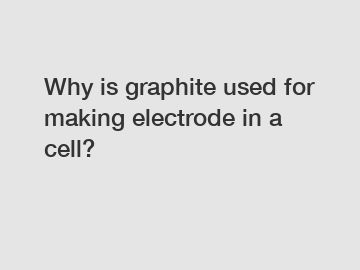Why is graphite used for making electrode in a cell?
Why is Graphite Used for Making Electrodes in a Cell?
Graphite is a material known for its excellent conductivity and stability, making it an ideal choice for a variety of applications, including electrodes in cells. In this article, we will explore the unique properties of graphite that make it suitable for this purpose and why it is widely used in various industries.
The Structure of Graphite.

Graphite, a form of carbon, has a unique atomic structure that consists of layered sheets of carbon atoms arranged in a hexagonal lattice. These layers are stacked on top of each other with weak forces called Van der Waals forces holding them together. This structure allows the carbon atoms within the layers to form strong covalent bonds, which gives graphite its exceptional properties.
High Conductivity.
One of the primary reasons graphite is used for making electrodes is its outstanding electrical conductivity. The delocalized electrons present in the layers of graphite can easily move from one atom to another, allowing the material to conduct electricity efficiently. This makes graphite a suitable choice for applications that require electrical current to flow through it, such as in primary and secondary cells.
Chemical Stability.
Another crucial property of graphite is its chemical stability. It is highly resistant to chemical reactions, making it suitable for use in harsh environments. Graphite has a low reactivity towards most chemicals, including corrosive substances, acids, and bases. This stability allows graphite electrodes to withstand various chemical reactions that may occur during the functioning of a cell, without deteriorating or getting damaged easily.
Heat Resistance.
Due to its high melting point and ability to withstand extreme temperatures, graphite is an excellent choice for applications involving heat. Graphite electrodes can endure high temperatures without deforming or melting, making them suitable for use in high-temperature cells. The excellent thermal stability of graphite also ensures that the electrodes maintain their structural integrity and performance over time, even under severe heat conditions.
Low Friction.
The layered structure of graphite also gives it a unique property called low friction or lubricity. The layers in graphite can easily slide over each other due to weak interlayer forces, resulting in a material with a slippery texture. This property makes graphite an ideal choice for applications where low friction is desired, such as in the manufacturing of batteries. The low friction nature of graphite electrodes reduces wear and tear, allowing for a longer lifespan and improved efficiency of the cell.
Conclusion.
In conclusion, graphite is an ideal material for making electrodes in cells due to its high conductivity, chemical stability, heat resistance, and low friction properties. These characteristics make it suitable for various applications where electrical current flow, chemical reactions, and extreme temperatures are involved. The use of graphite electrodes ensures the reliable and efficient performance of cells in a wide range of industries.
If you have any further questions or would like to learn more about the application of graphite in cells, please do not hesitate to contact us.
Are you interested in learning more about 550mm HP Graphite Electrode, 450mm UHP graphite electrode features, 350mm RP Graphite Electrode features? Contact us today to secure an expert consultation!
267
0
0

Comments
All Comments (0)